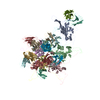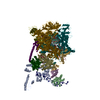[English] 日本語
 Yorodumi
Yorodumi- PDB-7cn2: Subparticle refinement of human papillomavirus type 16 pesudoviru... -
+ Open data
Open data
- Basic information
Basic information
| Entry | Database: PDB / ID: 7cn2 | |||||||||||||||||||||||||||
|---|---|---|---|---|---|---|---|---|---|---|---|---|---|---|---|---|---|---|---|---|---|---|---|---|---|---|---|---|
| Title | Subparticle refinement of human papillomavirus type 16 pesudovirus in complex with H16.001 Fab | |||||||||||||||||||||||||||
 Components Components |
| |||||||||||||||||||||||||||
 Keywords Keywords | IMMUNE SYSTEM/VIRAL PROTEIN / Virus / immune complex / IMMUNE SYSTEM-VIRAL PROTEIN complex | |||||||||||||||||||||||||||
| Function / homology |  Function and homology information Function and homology informationT=7 icosahedral viral capsid / endocytosis involved in viral entry into host cell / virion attachment to host cell / host cell nucleus / structural molecule activity Similarity search - Function | |||||||||||||||||||||||||||
| Biological species |  Human papillomavirus type 16 Human papillomavirus type 16 | |||||||||||||||||||||||||||
| Method | ELECTRON MICROSCOPY / single particle reconstruction / cryo EM / Resolution: 3.43 Å | |||||||||||||||||||||||||||
 Authors Authors | He, M.Z. / Li, S.W. | |||||||||||||||||||||||||||
 Citation Citation |  Journal: NPJ Vaccines / Year: 2020 Journal: NPJ Vaccines / Year: 2020Title: Structural characterization of a neutralizing mAb H16.001, a potent candidate for a common potency assay for various HPV16 VLPs. Authors: Weijin Huang / Maozhou He / Tingting Ning / Jianhui Nie / Feng Zhang / Qingbing Zheng / Rui Zhang / Ying Xu / Ying Gu / Shaowei Li / Youchun Wang /  Abstract: With more human papillomavirus (HPV) virus-like particle (VLP) vaccines to hit the market in future, a monoclonal antibody (mAb) with preferably comparable reactivity against vaccines from different ...With more human papillomavirus (HPV) virus-like particle (VLP) vaccines to hit the market in future, a monoclonal antibody (mAb) with preferably comparable reactivity against vaccines from different expression systems and bioprocesses is urgently needed for the potency characterization. Among all mAbs against HPV16 collected, rabbit mAb H16.001 is potently neutralizing with the highest affinity, recognizes an immune-dominant epitope, and can comparably react with HPV16 vaccines from various sources. Cryo-electron microscopic (cryo-EM) structure demonstrated that 360 H16.001 Fabs could bind to HPV16 capsid in preferable binding manner without steric hindrance between neighboring Fabs, potentially supporting its identification for VLP structural integrity and utility in monitoring VLP structural probity. This structural analysis indicated that mAb H16.001 afforded unbiased potency characterization for various HPV16 vaccines and was potential for use in vaccine regulation practice. This study also showed a model process for selecting suitable mAbs for potency assays of other vaccines. | |||||||||||||||||||||||||||
| History |
|
- Structure visualization
Structure visualization
| Movie |
 Movie viewer Movie viewer |
|---|---|
| Structure viewer | Molecule:  Molmil Molmil Jmol/JSmol Jmol/JSmol |
- Downloads & links
Downloads & links
- Download
Download
| PDBx/mmCIF format |  7cn2.cif.gz 7cn2.cif.gz | 705.5 KB | Display |  PDBx/mmCIF format PDBx/mmCIF format |
|---|---|---|---|---|
| PDB format |  pdb7cn2.ent.gz pdb7cn2.ent.gz | 595.5 KB | Display |  PDB format PDB format |
| PDBx/mmJSON format |  7cn2.json.gz 7cn2.json.gz | Tree view |  PDBx/mmJSON format PDBx/mmJSON format | |
| Others |  Other downloads Other downloads |
-Validation report
| Summary document |  7cn2_validation.pdf.gz 7cn2_validation.pdf.gz | 921.5 KB | Display |  wwPDB validaton report wwPDB validaton report |
|---|---|---|---|---|
| Full document |  7cn2_full_validation.pdf.gz 7cn2_full_validation.pdf.gz | 986.1 KB | Display | |
| Data in XML |  7cn2_validation.xml.gz 7cn2_validation.xml.gz | 115.1 KB | Display | |
| Data in CIF |  7cn2_validation.cif.gz 7cn2_validation.cif.gz | 168.7 KB | Display | |
| Arichive directory |  https://data.pdbj.org/pub/pdb/validation_reports/cn/7cn2 https://data.pdbj.org/pub/pdb/validation_reports/cn/7cn2 ftp://data.pdbj.org/pub/pdb/validation_reports/cn/7cn2 ftp://data.pdbj.org/pub/pdb/validation_reports/cn/7cn2 | HTTPS FTP |
-Related structure data
| Related structure data |  30414MC M: map data used to model this data C: citing same article ( |
|---|---|
| Similar structure data |
- Links
Links
- Assembly
Assembly
| Deposited unit | 
|
|---|---|
| 1 |
|
- Components
Components
| #1: Antibody | Mass: 11509.790 Da / Num. of mol.: 6 / Source method: isolated from a natural source / Source: (natural)  #2: Antibody | Mass: 13212.764 Da / Num. of mol.: 6 / Source method: isolated from a natural source / Source: (natural)  #3: Protein | Mass: 56340.953 Da / Num. of mol.: 6 Source method: isolated from a genetically manipulated source Source: (gene. exp.)  Human papillomavirus type 16 / Gene: L1 / Production host: Human papillomavirus type 16 / Gene: L1 / Production host:  Homo sapiens (human) / References: UniProt: P03101 Homo sapiens (human) / References: UniProt: P03101Has protein modification | Y | |
|---|
-Experimental details
-Experiment
| Experiment | Method: ELECTRON MICROSCOPY |
|---|---|
| EM experiment | Aggregation state: PARTICLE / 3D reconstruction method: single particle reconstruction |
- Sample preparation
Sample preparation
| Component | Name: human papillomavirus type 16 pesudovirus in complex with H16.001 Fab Type: COMPLEX / Entity ID: all / Source: MULTIPLE SOURCES |
|---|---|
| Source (natural) | Organism:  Human papillomavirus type 16 Human papillomavirus type 16 |
| Source (recombinant) | Organism:  Homo sapiens (human) Homo sapiens (human) |
| Details of virus | Empty: NO / Enveloped: NO / Isolate: OTHER / Type: VIRION |
| Natural host | Organism: Homo sapiens |
| Buffer solution | pH: 7.4 |
| Specimen | Embedding applied: NO / Shadowing applied: NO / Staining applied: NO / Vitrification applied: YES |
| Vitrification | Cryogen name: ETHANE |
- Electron microscopy imaging
Electron microscopy imaging
| Experimental equipment |  Model: Tecnai F30 / Image courtesy: FEI Company |
|---|---|
| Microscopy | Model: FEI TECNAI F30 |
| Electron gun | Electron source:  FIELD EMISSION GUN / Accelerating voltage: 300 kV / Illumination mode: FLOOD BEAM FIELD EMISSION GUN / Accelerating voltage: 300 kV / Illumination mode: FLOOD BEAM |
| Electron lens | Mode: BRIGHT FIELD |
| Image recording | Electron dose: 30 e/Å2 / Film or detector model: FEI FALCON II (4k x 4k) |
- Processing
Processing
| Software | Name: PHENIX / Version: 1.14_3259: / Classification: refinement | ||||||||||||
|---|---|---|---|---|---|---|---|---|---|---|---|---|---|
| EM software |
| ||||||||||||
| CTF correction | Type: PHASE FLIPPING ONLY | ||||||||||||
| 3D reconstruction | Resolution: 3.43 Å / Resolution method: FSC 0.143 CUT-OFF / Num. of particles: 274860 / Symmetry type: POINT |
 Movie
Movie Controller
Controller











 PDBj
PDBj




